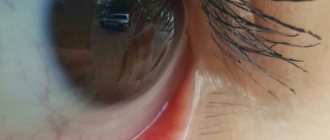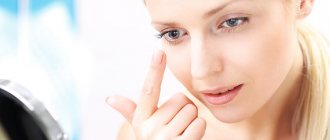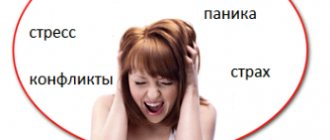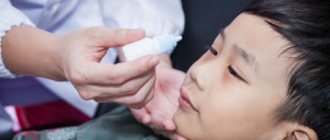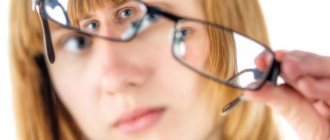Types of pimples on the eye
A pimple on the eye can signal the development of certain diseases. These include:
- pinguecula;
- barley;
- xanthelasma.
Chalazion is also classified as this type of rash. The nodular formation is round and dense. It develops due to blockage of the excretory ducts of the sebaceous gland: sebum accumulates under the skin. Incorrect treatment for barley and pathogenic microorganisms can cause chalazion. Milia, or millet, are formed due to mechanical injuries or against the background of inflammatory processes.
Pinguecula
Pinguecula is a pimple in the eye, which is a yellow formation that is located on the nasal side on the mucous membrane of the eye. A small compaction is a benign formation that does not degenerate into malignant. It does not impair vision; a pimple on the eye is considered an aesthetic defect. There may be several reasons for its development, including age-related and degenerative changes in the body.
Barley
Styes are most often located on the inside of the eyelid. The disease is accompanied by acute purulent inflammation of the hair follicle of the eyelash or the sebaceous gland located near the eyelash bulb. An internal stye is isolated, in which the meibomian gland becomes inflamed. Hordeolum affects the area under the eyelashes and occurs with reduced immunity. It is impossible to become infected with barley; it is not transmitted by airborne droplets or household contact.
Xanthelasma
Xanthelasma is a flat pimple on the eyelid, which is a benign yellow formation, when palpated the patient does not feel pain. It is not located on the lower eyelid. Xanthelasma is considered one of the manifestations of cutaneous xanthomatosis. The bubble can be single or multiple. The exact reasons for the appearance of a fatty plaque are unknown: xanthomatosis can develop against the background of impaired metabolism in the body, when fat is deposited in the papillary layer of the skin.
Phlegmon
It often causes a bump to appear on the outside of the lower or upper eyelid. Usually a complication of barley or other foci of infection in the body. Sometimes injuries to the skin and mucous membranes can trigger inflammation. The formation of a compaction is accompanied by fever, headache, and swelling of the lymph nodes.
A lump on the eye often signals the development of serious health problems. If it appears, you should contact an ophthalmologist or surgeon. It is forbidden to open the growths yourself. This can lead to dangerous complications and scarring.
Reasons for appearance
In order to select the most effective treatment, it is necessary to identify the exact cause of the formation. These include:
- allergic reaction
- internal and external stimuli;
- demodicosis;
- infections;
- Moll cyst;
- papillomas;
- conjunctivitis;
- ophthalmoherpes;
- immune system disorders;
- gastrointestinal problems;
- low-quality cosmetics.
In most cases, diseases develop for several reasons, which negatively affect the functioning of the body.
Allergic reaction
A pimple on the upper or lower eyelid, in the corner of the eye, may appear under the influence of irritants that provoke allergies. These include:
- dust;
- cosmetics and soaps that are unsuitable for your skin type;
- pollen.
Eating exotic fruits, the body's reaction to the consumption of which has not been tested in advance, can lead to the development of allergies. Neglecting personal hygiene rules can accelerate the formation of acne. Allergies are often accompanied by additional symptoms: redness, swelling of the eyes, irritation, itching and increased tearing.
Internal and external stimuli
Bubbles around the eyes, on the eyelids and mucous membranes can form under the influence of internal and external irritants. Establishing the exact factor is possible only after a medical examination, on the basis of which the doctor prescribes treatment. Internal factors are considered:
- hormonal disbalance;
- long-term use of antibiotics;
- diseases of the digestive tract.
External factors that accelerate the appearance of acne include:
- failure to comply with personal hygiene rules;
- decorative cosmetics;
- long exposure to the sun.
Foundation, powder and other concealing cosmetics cause clogged pores and heat the skin: oxygen deficiency leads to the withering of the dermis.
Demodicosis
The causative agent of demodicosis is the eel, which lives in dust. The pathology has characteristic signs:
- itching;
- tearfulness;
- eyelash loss;
- feeling of “sand” in the eye.
The eye mite affects the eyebrows, skin in the forehead and chin area, and ear canals. Pathology manifests itself against the background of:
- chronic disorders of the functional activity of the digestive tract;
- endocrine system disorders;
- hepatitis A;
- metabolic disorders in the body;
- ophthalmological pathologies;
- increased oily skin;
- seborrhea.
The causative agent of demodicosis causes an acute allergic reaction.
Infection
Infectious lesions of the organs of vision provoke the appearance of purulent pimples and dense pimples. These include:
- trachoma;
- blepharitis;
- keratitis;
- ulcerative lesions of the cornea by staphylococci;
- dacryocystitis.
Ophthalmological disorders of infectious etiology require immediate contact with a medical institution. Infectious diseases have characteristic symptoms:
- thick discharge;
- redness;
- swelling of the eyes;
- pain accompanied by blurred vision and photophobia;
- dilation or constriction of the pupils;
- lacrimation;
- peeling of the skin.
The pathological process can be triggered by fungi, viruses and bacteria.
Moll cyst
A cyst forms on the eyelids during a change in the functional activity of the sweat glands of the eyes. 2 or more bubbles with transparent contents appear. After some time they disappear, the disease is often chronic. The pathology is accompanied by lacrimation and photophobia; hyperemia and swelling of the eyelids may appear. Pimply rashes take on a purulent character and are accompanied by the formation of crusts.
At the initial stage, spots may appear on the eyelids, which disappear on their own after a few days. During an exacerbation, the bubbles merge with each other. In the severe stage, Moll cysts are accompanied by the formation of scars and scabs, which increases the risk of entropion and eversion of the eyelids. In the absence of timely treatment, the patient's condition worsens: body temperature rises, general malaise and hyperesthesia are observed.
Papilloma
Papilloma is understood as a benign skin growth formed as a result of the rapid proliferation of epithelial cells. Pathological neoplasms are caused by the HPV virus. The disease affects men and women equally. Papilloma can occur on any part of the eyes, both on the upper and lower eyelids. The virus can spread in several ways:
- sexually;
- during childbirth;
- by everyday means.
The virus can be transmitted during hair removal or shaving through instruments not treated with an antiseptic.
Conjunctivitis
Pimples on the eyes of children and adults often appear due to viral conjunctivitis. The disease is accompanied by a pathological inflammatory process, which is localized on the outer mucosa of the eye. The disease can affect the inner surface of the eyelids. Conjunctivitis is caused by the penetration of an infection into the human body that affects the respiratory tract (a type of adenovirus or herpes). The contagiousness of the pathology is high, so it is epidemic in nature.
In addition to bubbles with transparent contents, clinical signs of the disease include:
- increased lacrimation;
- rupture of blood vessels inside the eye;
- itching;
- pain;
- photophobia;
- swelling of the eyelids.
With viral conjunctivitis, the lymph nodes are affected, so the person experiences pain in the mandibular and parotid region.
Ophthalmoherpes
Ophthalmoherpes affects the ocular appendages and the eyeball. The disease is caused by herpes simplex virus type 1 or 2. The characteristic symptoms of the disease are pain, photophobia, lacrimation and partial blurred vision. There are several main forms:
- primary;
- front;
- rear;
- recurrent.
A seal forms on the inner surface of the upper eyelid, and the eye swells. Purulent or mucous discharge is accompanied by itching and severe burning. Vision is blurred, the visible image is distorted.
Immune system disorder
One of the main reasons for the formation of acne on the eyes is considered to be a weakened immune system. Weakening can be temporary due to hypothermia, fatigue, and in women - before the onset of menstruation and menopause. Permanently weakened immunity is observed in people suffering from chronic diseases, immune deficiency or leading an unhealthy lifestyle.
Weakened immunity creates conditions favorable for the proliferation of pathogenic microorganisms. Bacteria rapidly multiply near the mouth of the sebaceous glands, causing their inflammation. The immune system is not able to independently stop the spread of inflammatory processes and ensure the normal functioning of the skin.
Gastrointestinal problems
The causes of acne around or inside the eyes include diseases of the gastrointestinal tract. This:
- low acidity;
- dysbacteriosis;
- gastroduodenitis;
- duodenitis;
- erosive and ulcerative lesions of the stomach and duodenum;
- pancreatitis;
- gastritis.
Improper nutrition leads to disruption of the functional activity of the digestive organs. The body stops quickly digesting food, the balance of fats, proteins and carbohydrates is disrupted. Useful components (vitamins, micro- and macroelements) are supplied with food in limited quantities, which leads to a weakened immune system.
Low-quality cosmetics
Low-quality decorative cosmetics often contain parabens, which can provoke the development of an allergic reaction. An allergy to powder, foundation or eye shadow is caused by the body’s individual reaction to some of the components included in the product. At the initial stage of the allergic reaction, pimples are small, often single, and have transparent contents. When a bacterial infection joins an existing allergy, pus forms inside the pimple.
Additional symptoms
The nature of the manifestation of additional symptoms directly depends on the type of lesion. General symptoms:
- itching;
- pain when blinking;
- swelling of the periocular area and eyelid;
- inflammation;
- redness of the white of the eye;
- burning.
Often, clinical signs of infectious lesions of the organs of vision include eyelashes that have stuck together in the morning due to heavy discharge.
White painless
White, painless pimples are formed due to clogging of pores with sebum. The main symptoms are rashes under the eyes and on the upper eyelid. In the absence of proper treatment, the spots increase in size and fill with pus. Excessive tearing, pain when blinking, and burning sensation occur when a bacterial infection is attached.
Painful red bump under the eye
A painful red bump under the eye is often called a stye. Its formation is accompanied by many unpleasant symptoms that cause discomfort to the patient. A small bump initially forms on the lower and upper eyelids, becoming red over time. Due to severe inflammation, the eye swells.
A few days after formation, a white head appears on the pimple, indicating the presence of pus. There is pain when blinking, eyelashes stick together after sleep. The stye breaks through in a few days and the pus comes out.
Reddish rash
A red rash is characteristic of dermatitis, urticaria and other allergic reactions. Symptoms that can negatively affect the patient’s well-being:
- inflammation of the lower and upper eyelids;
- pain;
- redness of the whites of the eyes;
- increased tearfulness;
- blurred vision;
- swelling of the eyes.
In the absence of timely treatment, the rash turns into pimples with purulent contents.
Boils near the eyes
Such a ball in the form of a nodule with a yellow purulent head is quite dangerous. Often the skin may even swell. In this case, not only the eyelid swells, but also half of the face.
Often a person feels aches, weakness, temperature rises, and headaches.
Sometimes a ball with purulent contents under the eye “ripens”, then the mixture of liquid and pus breaks through and flows out. And in the place where the boil was, a scar remains.
When you notice something that looks like a boil, under no circumstances try to squeeze it out.
A not so harmless phenomenon is a lump next to the eye. The sooner you see a doctor, the better.
Localization of the lesion
Pimples can be located in different parts of the eye. It is not particularly important where the formations appeared: they will cause physical, aesthetic and psychological discomfort to the patient.
Upper eyelid
Stye, white, red pimples and rashes may form on the upper eyelid. In most cases, they do not affect vision, but stye is accompanied by severe pain when blinking.
Lower eyelid
White purulent pimples and styes form on the lower part of the eye. The formation is accompanied by redness, inflammation and increased tearing. When blinking, the patient experiences pain; after sleep, the eyelashes may stick together.
Under the eye
Localization of acne, comedones, white pimples and red rashes is under the eye. In this case, it is necessary to consult a doctor in time, who will select an effective treatment, otherwise the risk of developing inflammatory processes increases. Pimples will spread to all parts of the eye.
In the eye
Small fatty plaques may form on the whites of the eyes. The exact cause is revealed during the diagnosis of neoplasms. This could be an allergic reaction to cosmetics (washing gel, eye shadow, toner). Plaques also form after mechanical trauma to the organ of vision.
Papilloma in the eye area
Sometimes the skin around the eyes may become covered with wart-like formations. Papillomas have a rough surface. Such growths look unsightly, especially when they are large and very visible.
It may be a ball on a leg or a flat growth.
The reason for this symptom is that a person has an active form of human papillomavirus in the body.
Under no circumstances should you use home methods on the skin near your eyes. If you choose the wrong recipe, your skin can be seriously burned. It is better to consult a doctor and he will recommend a way to eliminate papilloma.
Diagnostics
Before starting treatment, the doctor must identify the exact cause of the formations. After an initial examination by an ophthalmologist, the patient should receive a referral for the following studies:
- biochemical and general blood test;
- microbiological smear;
- instrumental examination of the eye;
- MRI, CT and ultrasound of the visual organs.
In advanced cases, additional consultation will be required:
- oncologist;
- dermatologist;
- gastroenterologist;
- endocrinologist.
If there is an infection in the body, the patient should consult an infectious disease specialist.
Treatment options
Pimples formed in any part of the eye require the use of medications that act locally. As an additional remedy, the doctor may prescribe physiotherapeutic procedures that have a beneficial effect on the patient’s body.
Drops
Bactericidal drops are prescribed for acne that contains pus inside. They are purchased in pharmacies without a prescription. An ophthalmologist will help you choose the safest and most effective medications. Medicines in this category must be used according to the instructions: for barley, the liquid is instilled 2-3 times a day, 1 drop into each eye.
The course of application is 7-10 days. Most often, after a therapeutic course, a percentage completely recovers: inflammation, pain and redness disappear.
Injections
For extensive rashes accompanied by inflammation, injections of antibiotics are required. Injections are given directly into the area affected by inflammation. Injecting yourself is strictly prohibited. Antibiotics are selected by the attending physician; injections can be combined with ophthalmic drops.
Physiotherapy
Neoplasms in the eyes can be cured with physiotherapy. Physiotherapy is combined with drug treatment, which makes it possible to increase the effectiveness of medications. Physiotherapeutic methods for treating acne:
- local darsonvalization improves nutrition and blood circulation in tissues, reduces sebum production;
- ozone therapy accelerates the death of pathogenic microorganisms, accelerates tissue regeneration and improves blood microcirculation;
- Magnetic therapy improves blood circulation and stops the spread of inflammatory processes to healthy tissue;
- Thalassotherapy increases the protective functions of the skin and normalizes metabolic processes at the cellular level.
Short-wave ultraviolet irradiation (SWUV) is used to treat and prevent acne.
Removal methods
The methods described below are considered radical. They are prescribed if drug treatment is ineffective.
Mechanical
Mechanical cleaning is carried out in a medical facility under the strict supervision of the attending physician. Algorithm:
- wash and cleanse the dermis with a scrub;
- A mask is applied to the surface and left for 15 minutes;
- after this time, the products are washed off;
- the cleansing procedure is performed;
- after cleaning, darsonvalization is carried out using a special device (exposure to electromagnetic pulses of different frequencies).
After the procedure, you must apply any suitable mask to the skin. Leave it on for 15 minutes, then wash off with warm water.
Electrocoagulation
Electrocoagulation refers to the cauterization of soft tissues by electric current. The method helps to get rid of warts, warts, papillomas, acne and post-acne, moles and calluses.
Curettage
Curettage is prescribed for single rashes. The skin around the cyst is punctured and its contents are squeezed out along with the capsule. Before piercing, it is necessary to thoroughly clean and disinfect the skin.
Laser therapy
Laser therapy is considered the most effective and popular. During the procedure, layer-by-layer high-precision elimination of acne occurs without the mechanical and thermal effects of the device on healthy tissue. For these purposes, a CO2 laser is used.
Treating milia at home
Millet grass can be removed at home, but to do this you need to be extremely careful and have the appropriate skills.
Removing primary grasses
To remove milia yourself, you must follow certain recommendations from cosmetologists.
- Clean the dermis using a wash gel (soap) and an alcohol solution.
- Steam the skin to open the pores.
- Use your fingers to squeeze out the contents of the millet. Cosmetologists can use a special tool - a puncture needle, but doing this yourself is strictly not recommended.
- The resulting wound is disinfected.
If milia have reached the size of a wen, you need to seek help from a doctor; self-medication is ineffective and even dangerous.
Therapy for secondary milia
Secondary milia do not require removal; they most often appear in groups. In this case, you only need to treat the affected area with salicylic ointment or salicylic-zinc paste. You can also use badyagu to reduce the outbreak.
A mask made from badyagi and peroxide is quite effective. As a result of such procedures, redness and peeling of the facial skin may appear. This is the norm. After a few days, the pimples will peel off and disappear.
ethnoscience
Folk remedies must be used in combination with drug treatment. The complex effect helps to cope with the tumor in a few days. Warming is very popular; the procedure can be used even for barley. The heat should be dry; the barley itself and the skin around it should not be soaked. This increases the risk of pathogenic microorganisms spreading through healthy tissues. Dry heat is most effective at an early stage in the absence of an abscess.
A chicken egg must be boiled, wrapped in natural fabric and applied to the sore eye until it cools completely. Puree the boiled potatoes, wrap them in cloth and apply them to the swollen eyelid. You can heat sea salt, the application algorithm is the same.
Lotions based on medicinal plants are considered no less effective. The prepared product must be moistened with a tampon or a bandage folded several times and applied to the sore spot for 5-15 minutes. Cooking recipes:
- Pharmaceutical chamomile (15 g) is poured with a glass of boiling water and left for 30 minutes. The finished infusion is decanted, cooled and used for its intended purpose as a rinse or lotion.
- Black tea (1 tsp) is poured into 100 ml of boiling water. Insist for 10 hours. You can rinse your eyes with the liquid or make lotions 3-4 times a day.
- Plantain (fresh or dried leaves) is poured with water in a ratio of 3:1. The product is infused in a warm place for 40-50 minutes, then expressed. You can wash your face with the infusion 2-3 times a day.
- Soak a cotton swab in pharmaceutical tincture of propolis and cauterize the stye. The procedure can be performed up to 3 times a day.
- A leaf is cut from the bottom of the aloe, wrapped in cling film and placed in the refrigerator for 10-12 hours (overnight). In the morning, the thorns are cut off the leaf, the skin is removed, cut into small pieces and ground in a blender. The juice is squeezed out of the resulting pulp and used to burn the pimple 3-4 times a day. Children should not apply pure aloe juice to their skin: it should be diluted with water (in equal parts).
Honey is effective at an early stage. The beekeeping product has anti-inflammatory, disinfectant, decongestant and wound-healing effects. The compress should be used with caution by hypersensitive people prone to allergies.
Treatment methods
Dermatologists or cosmetologists deal with the problem of millet. There are many ways to remove milia under the eyes, but it must be done by a qualified professional. Self-medication does not bring a noticeable effect, but contributes to the development of complications - inflammation, scarring.
How to get rid of millet at home?
There are many folk remedies that help remove white spots around the eyes. They are safe because they consist of natural ingredients. But it will take a long time to be treated with them, since the effectiveness of traditional recipes is low.
- Oil with propolis. To prepare this remedy, you will need to take a piece of propolis, grind it thoroughly, and pour in sunflower oil. Leave in a cold place for three days. Then apply milia under the eyes every morning for a month.
- Onion honey Millet on the eyelid responds well to treatment with this remedy. You need to take a white onion, dip it in honey, then place it in the oven for 30 minutes at a temperature of 100*C. Crush the onion until it becomes mushy. Lubricate the points in the morning and evening for a month.
- The work of the sebaceous glands is regulated by aloe. You need to take a few fresh leaves of the plant and squeeze the juice out of them. Add a spoonful of alcohol. Wipe white bubbles with the product before going to bed.
- A mask made from viburnum juice has an anti-inflammatory and drying effect. Crush a handful of viburnum berries with a masher. Squeeze out the juice, add ground oatmeal. The mixture is applied to the white spots until dry, then washed off with cool water.
- You can use castor oil for milia if you mix it with tea tree oil. The mixture is used to treat the points in the morning and evening.
Paraffin helps soften milia. Pharmacies sell special paraffin masks that only need to be applied to the skin according to the instructions. You can use regular paraffin by preparing the product yourself.
You need to take paraffin and melt it in a water bath. Cool slightly without allowing it to harden. Apply to the area of whiteheads using a brush. When the paraffin hardens, carefully remove it.
The use of folk remedies for milia on the eyelids should be agreed upon with a dermatologist or cosmetologist.
Medications
Medicines are also not effective enough to remove white spots on the skin around the eyes.
- Use salicylic or boric alcohol to wipe the face.
- Creams containing urea - “Emolium”, “Lipobase” - have a certain effect.
- Scrubs and peelings are widely used. For the face, you can use a scrub with large granules. If clear patches have formed under the eyes or on the eyelids, only fine peeling is allowed.
Forecast
A pimple under the eye and on the eyeball is considered not only an aesthetic defect; the neoplasm is accompanied by inflammatory processes, profuse lacrimation, swelling of the eyelid, severe itching and visual disturbances. Education in the eye area is dangerous due to complications and therefore requires timely treatment. In most cases, the prognosis is favorable; it depends on the size of the pimple, the reasons for its appearance, the age of the patient, the individual characteristics of his body and skin type.
Squeezing pimples or taking medications on your own is strictly prohibited. In this case, the prognosis will worsen, and amateur activities often lead to the development of complications.
Prevention
Preventive measures help prevent the appearance of stye, acne and other rashes. These include:
- compliance with all rules of personal hygiene;
- the use of high-quality gels and eye creams;
- regular application of moisturizing and nourishing masks;
- protection of the organs of vision from pollen dust and other contaminants.
You cannot use other people's scarves or sleep masks - some infectious diseases are transmitted by contact. In summer, it is recommended to limit your exposure to the sun and, if necessary, wear sunglasses. If any rash appears, you should immediately consult an ophthalmologist. Experts advise regularly strengthening your immune system. People who regularly use tobacco products and alcoholic beverages need to completely give up bad habits.
It is important to monitor your diet: the diet should be balanced. It should include fresh fruits, vegetables and herbs. Junk foods (fatty, spicy, salty, sour) must be avoided. It is recommended to reduce the amount of baked goods and sweets.
Physical activity plays a major role in the formation of immunity. For people who have not previously exercised, it is best to start with morning exercises and daily evening walks. The body is gradually accustomed to active sports (swimming, running) to avoid overwork.
